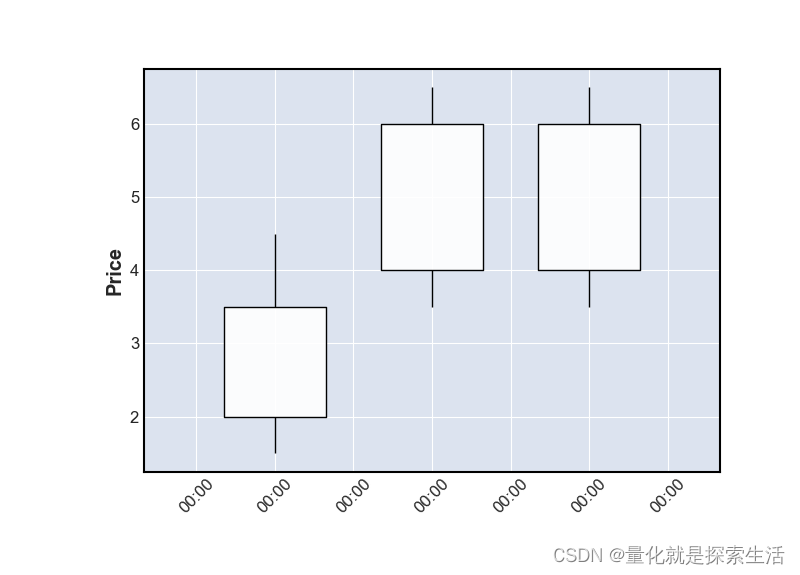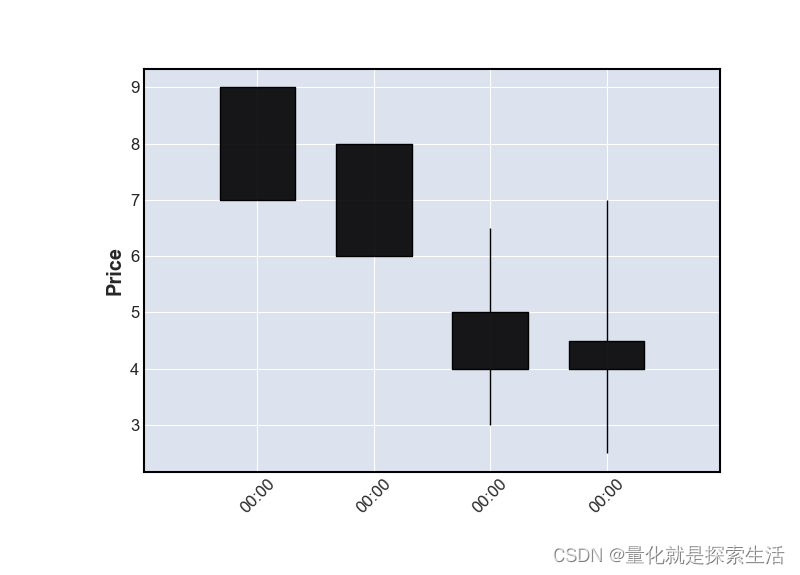Ta-Lib源码解析(三):蜡烛图指标 (Candlestick Indicator) #(附Python重构代码和示意图)(补充中)
TA_Lib指标目录
- 3.(蜡烛图指标)Candlestick Indicator
- 一. 前言
- 二. 单K线模型
- CDLBELTHOLD(捉腰带线)
- CDLCLOSINGMARUBOZU (收盘缺影线)
- CDLDOJI(doji十字)
- CDLDRAGONFLYDOJI (蜻蜓十字)
- CDLGRAVESTONEDOJI (墓碑十字)
- 三. 双K线模型
- CDLCOUNTERATTACK (反击线)
- CDLDARKCLOUDCOVER(乌云压顶)
- CDLDOJISTAR(十字星)
- CDLENGULFING (吞噬模式)
- CDLHAMMER(锤头)
- 四. 三K线模型
- CDL2CROW(双乌鸦)
- CDL3BLACKCROW(三乌鸦)
- CDL3INSIDE(三内部上涨和下跌)
- 三内部上涨
- 三内部下跌
- CDL3OUTSIDE(三外部上涨和下跌)
- 三外部上涨(下跌同理)
- CDL3STARSINSOUTH (南方三星)
- CDL3WHITESOLDIERS (三白兵)
- CDLABANDONEDBABY(弃婴)
- CDLADVANCEBLOCK(大敌当前)
- 情况1:上升阻碍由于第二根bar的短实体
- 情况2:上升阻碍由于第三根bar的短实体
- 情况3:上升阻碍由于逐渐变短的实体和不短的上影线
- 情况4:上升阻碍由于第三根较短的实体和长上影线
- CDLEVENINGDOJISTAR (十字暮星)
- CDLEVENINGSTAR (暮星)
- CDLGAPSIDESIDEWHITE (向上/下跳空并列阳线)
- 五. 四K线模型
- CDL3LINESTRIKE(三线打击)
- 三连阳情况
- CDLCONCEALBABYSWALL(藏婴吞没)
- 六. 五K线模型
- CDLBREAKAWAY(脱离)
- 免责声明
3.(蜡烛图指标)Candlestick Indicator
蜡烛图指标为识别K线形态的指标,笔者认为重点在于定义方式所提供的思路,背后的投资逻辑可以借鉴但不建议直接参考
文档的翻译内容和源码逻辑存在不一致的现象,笔者分别列出中文百科中的定义和源码实际逻辑,供大家参考
一. 前言
技术分析理论中的一些模糊词,ta-lib中给出了精确的定义
源码
见 ta_global.c
TA_RetCode TA_RestoreCandleDefaultSettings( TA_CandleSettingType settingType )
{
const TA_CandleSetting TA_CandleDefaultSettings[] = {
/* real body is long when it's longer than the average of the 10 previous candles' real body */
{ TA_BodyLong, TA_RangeType_RealBody, 10, 1.0 },
/* real body is very long when it's longer than 3 times the average of the 10 previous candles' real body */
{ TA_BodyVeryLong, TA_RangeType_RealBody, 10, 3.0 },
/* real body is short when it's shorter than the average of the 10 previous candles' real bodies */
{ TA_BodyShort, TA_RangeType_RealBody, 10, 1.0 },
/* real body is like doji's body when it's shorter than 10% the average of the 10 previous candles' high-low range */
{ TA_BodyDoji, TA_RangeType_HighLow, 10, 0.1 },
/* shadow is long when it's longer than the real body */
{ TA_ShadowLong, TA_RangeType_RealBody, 0, 1.0 },
/* shadow is very long when it's longer than 2 times the real body */
{ TA_ShadowVeryLong, TA_RangeType_RealBody, 0, 2.0 },
/* shadow is short when it's shorter than half the average of the 10 previous candles' sum of shadows */
{ TA_ShadowShort, TA_RangeType_Shadows, 10, 1.0 },
/* shadow is very short when it's shorter than 10% the average of the 10 previous candles' high-low range */
{ TA_ShadowVeryShort, TA_RangeType_HighLow, 10, 0.1 },
/* when measuring distance between parts of candles or width of gaps */
/* "near" means "<= 20% of the average of the 5 previous candles' high-low range" */
{ TA_Near, TA_RangeType_HighLow, 5, 0.2 },
/* when measuring distance between parts of candles or width of gaps */
/* "far" means ">= 60% of the average of the 5 previous candles' high-low range" */
{ TA_Far, TA_RangeType_HighLow, 5, 0.6 },
/* when measuring distance between parts of candles or width of gaps */
/* "equal" means "<= 5% of the average of the 5 previous candles' high-low range" */
{ TA_Equal, TA_RangeType_HighLow, 5, 0.05 }
};
int i;
if( settingType > TA_AllCandleSettings )
return TA_BAD_PARAM;
if( settingType == TA_AllCandleSettings )
for( i = 0; i < TA_AllCandleSettings; ++i )
TA_Globals->candleSettings[i] = TA_CandleDefaultSettings[i];
else
TA_Globals->candleSettings[settingType] = TA_CandleDefaultSettings[settingType];
return TA_SUCCESS;
}
翻译
TA_BodyLong: 当期蜡烛体长度超过过去十日蜡烛体长度的平均值
TA_ShadowVeryLong: 当期蜡烛体长度超过过去十日蜡烛体长度的平均值的三倍
TA_BodyShort: 当期蜡烛体长度低于过去十日蜡烛体长度的平均值
TA_BodyDoji: 蜡烛体类似于十字线,短于过去十日蜡烛体长度的平均值的10%
TA_ShadowLong: 当期影线长度长于蜡烛体长度
TA_ShadowVeryLong: 当期影线长度长于蜡烛体长度两倍
TA_ShadowShort: 当期影线短于前十期影线长度平均值的一半
TA_ShadowVeryShort: 当期影线短于前十期high-low长度平均值的10%
TA_Near: 小于前五期20%的high-low长度平均值
TA_Far: 大于前五期60%的high-low长度平均值
TA_Equal: 小于前五期5%的high-low长度平均值
二. 单K线模型
CDLBELTHOLD(捉腰带线)
python函数原型:
cdlbelthold= CDL2BELTHOLD(open, high, low, close)
解释:
看涨为例,其开市价位于当日的最低点,然后市场一路上扬。

重构代码(来自ta_CDLBELTHOLD.c, 有修改, 只保留逻辑):
def CDLBELTHOLD_(open, high, low, close):
_len = len(open)
open, high, low, close = pd.Series(open), pd.Series(high), pd.Series(low), pd.Series(close)
if _len >= 11:
high_low_range = high - low
shadow_very_short = high_low_range.rolling(10).mean().shift(1) * 0.1
real_body = abs(open - close)
body_long = real_body.rolling(10).mean().shift(1)
shadow_upper = high - np.maximum(close, open)
shadow_lower = np.minimum(close, open) - low
condition_1 = real_body > body_long
condition_2_1 = (close > open) & (shadow_lower < shadow_very_short)
condition_2_2 = (close < open) & (shadow_upper < shadow_very_short)
cdlbelthold = np.where(condition_1 & condition_2_1, 100, 0)
cdlbelthold = np.where(condition_1 & condition_2_2, -100, cdlbelthold)
else:
cdlbelthold = np.zeros(_len).astype(int)
return cdlbelthold
CDLCLOSINGMARUBOZU (收盘缺影线)
python函数原型:
cdlclosingmarubozu= CDLCLOSINGMARUBOZU(open, high, low, close)
解释:
中文百科:一日K线模式,以阳线为例,最低价低于开盘价,收盘价等于最高价, 预示着趋势持续。
源码与抓腰带线几乎相同
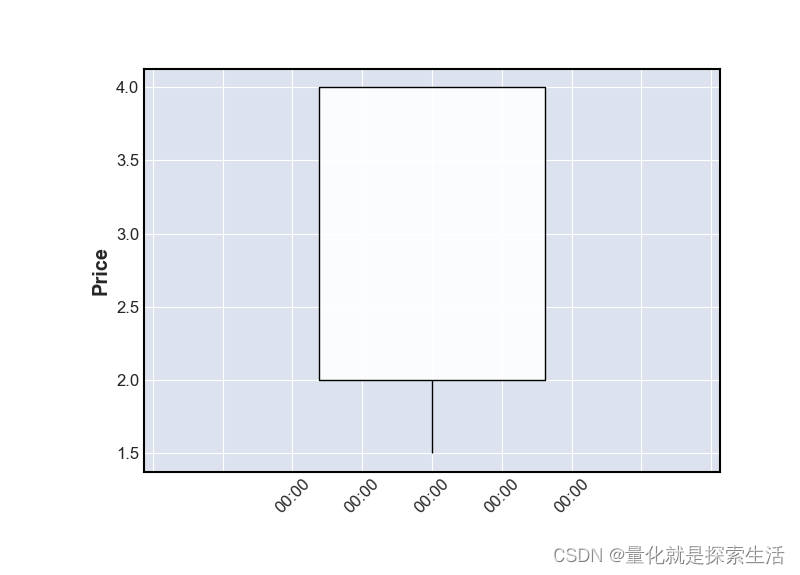
重构代码(来自ta_CDLBELTHOLD.c, 与BELTHOLD极其相似应该直接复制粘贴该条件):
def CDLCLOSINGMARUBOZU_(open, high, low, close):
_len = len(open)
open, high, low, close = pd.Series(open), pd.Series(high), pd.Series(low), pd.Series(close)
if _len >= 11:
high_low_range = high - low
shadow_very_short = high_low_range.rolling(10).mean().shift(1) * 0.1
real_body = abs(open - close)
body_long = real_body.rolling(10).mean().shift(1)
shadow_upper = high - np.maximum(close, open)
shadow_lower = np.minimum(close, open) - low
condition_1 = real_body > body_long
condition_2_1 = (close > open) & (shadow_upper < shadow_very_short)
condition_2_2 = (close < open) & (shadow_lower < shadow_very_short)
cdlclosingmarubozu = np.where(condition_1 & condition_2_1, 100, 0)
cdlclosingmarubozu = np.where(condition_1 & condition_2_2, -100, cdlclosingmarubozu)
else:
cdlclosingmarubozu = np.zeros(_len).astype(int)
return cdlclosingmarubozu
CDLDOJI(doji十字)
python函数原型:
cdldoji = CDLDOJI(open, high, low, close)
解释:
单k线模型,十字线
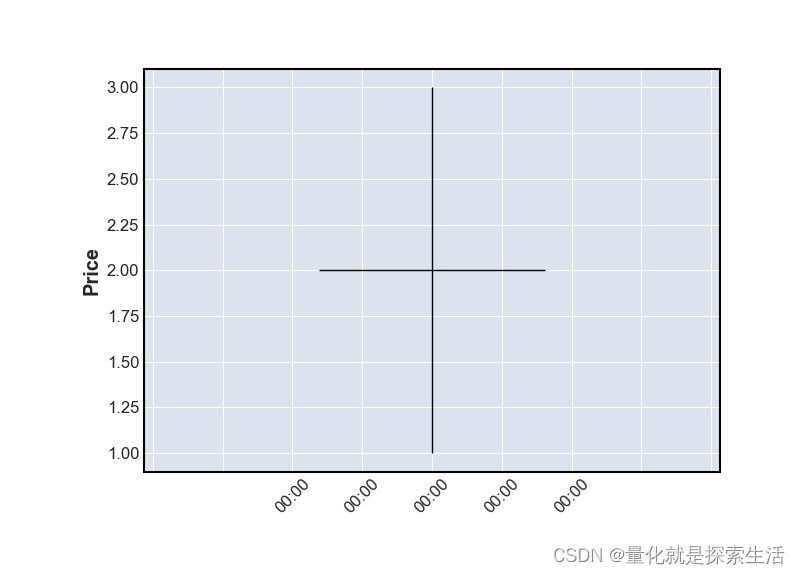
重构代码(来自ta_CDLDOJI.c, 有修改, 只保留逻辑):
def CDLDOJI_(open, high, low, close):
_len = len(open)
open, high, low, close = pd.Series(open), pd.Series(high), pd.Series(low), pd.Series(close)
if _len >= 11:
real_body = abs(open - close)
high_low_range = abs(high - low)
doji = high_low_range.rolling(10).mean().shift(1) * 0.1
condition = real_body < doji
cdldoji = np.where(condition, 100, 0)
else:
cdldoji = np.zeros(_len).astype(int)
return cdldoji
CDLDRAGONFLYDOJI (蜻蜓十字)
python函数原型:
cdldragonflydoji= CDLDRAGONFLYDOJI (open, high, low, close)
解释:
单k线模型,T字线

重构代码(来自ta_CDLDRAGONFLYDOJI.c, 有修改, 只保留逻辑):
def CDLDRAGONFLYDOJI_(open, high, low, close):
_len = len(open)
open, high, low, close = pd.Series(open), pd.Series(high), pd.Series(low), pd.Series(close)
if _len >= 11:
real_body = abs(open - close)
high_low_range = abs(high - low)
shadow_upper = high - np.maximum(close, open)
shadow_lower = np.minimum(close, open) - low
shadow_very_short = high_low_range.rolling(10).mean().shift(1) * 0.1
doji = high_low_range.rolling(10).mean().shift(1) * 0.1
condition = (real_body < doji) & (shadow_upper < shadow_very_short) & (shadow_lower > shadow_very_short)
cdldragonflydoji = np.where(condition, 100, 0)
else:
cdldragonflydoji = np.zeros(_len).astype(int)
return cdldragonflydoji
CDLGRAVESTONEDOJI (墓碑十字)
python函数原型:
cdlgravestonedoji = CDLGRAVESTONEDOJI(open, high, low, close)
解释:
单k线模型,倒T字线
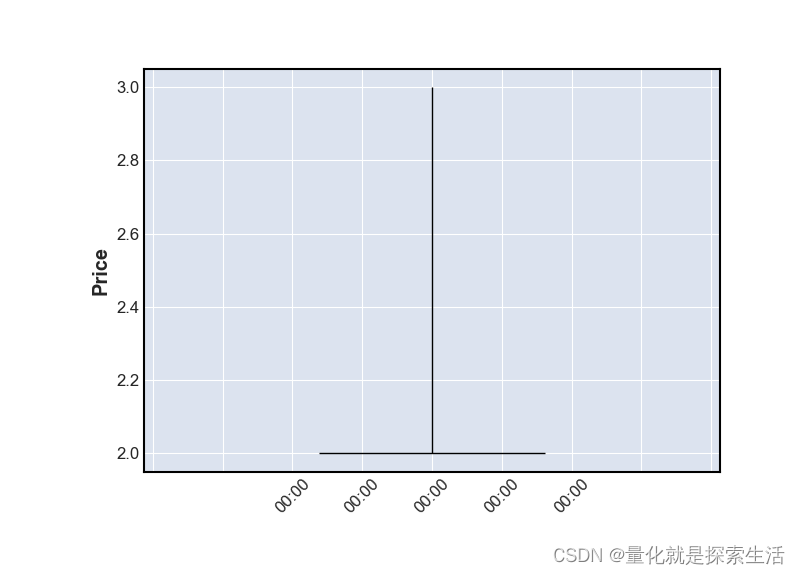
重构代码(来自ta_CDLGRAVESTONEDOJI.c, 有修改, 只保留逻辑):
def CDLGRAVESTONEDOJI_(open, high, low, close):
_len = len(open)
open, high, low, close = pd.Series(open), pd.Series(high), pd.Series(low), pd.Series(close)
if _len >= 11:
real_body = abs(open - close)
high_low_range = abs(high - low)
shadow_upper = high - np.maximum(close, open)
shadow_lower = np.minimum(close, open) - low
shadow_very_short = high_low_range.rolling(10).mean().shift(1) * 0.1
doji = high_low_range.rolling(10).mean().shift(1) * 0.1
condition = (real_body < doji) & (shadow_upper > shadow_very_short) & (shadow_lower < shadow_very_short)
cdlgravestonedoji = np.where(condition, 100, 0)
else:
cdlgravestonedoji = np.zeros(_len).astype(int)
return cdlgravestonedoji
三. 双K线模型
CDLCOUNTERATTACK (反击线)
python函数原型:
cdlcounterattack = CDLCOUNTERATTACK(open, high, low, close)
解释:
双k线模型,一大阴一大阳,且收盘价接近,
延续第二根K线地行情
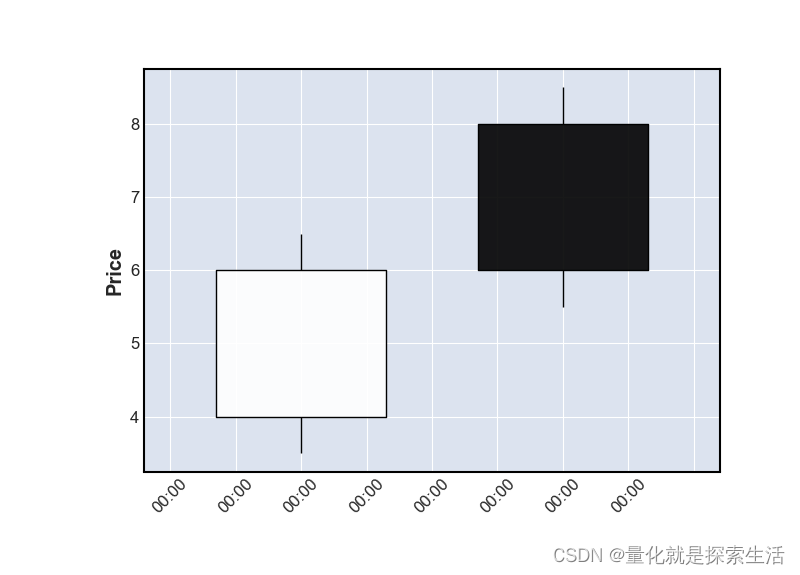
重构代码(来自ta_CDLCOUNTERATTACK.c, 有修改, 只保留逻辑):
def CDLCOUNTERATTACK_(open, high, low, close):
_len = len(open)
open, high, low, close = pd.Series(open), pd.Series(high), pd.Series(low), pd.Series(close)
if _len >= 12:
real_body = abs(open - close)
high_low_range = abs(high - low)
equal = high_low_range.rolling(5).mean().shift(1) * 0.05
body_long = real_body.rolling(10).mean().shift(1)
condition_1_1 = (close.shift(1) > open.shift(1)) & \
(close < open)
condition_1_2 = (close.shift(1) < open.shift(1)) & \
(close > open)
condition_2 = (real_body.shift(1) > body_long.shift(1)) & \
(real_body > body_long) & \
(close <= close.shift(1) + equal.shift(1)) & \
(close >= close.shift(1) - equal.shift(1))
cdlcounterattack = np.where(condition_1_1 & condition_2, -100, 0)
cdlcounterattack = np.where(condition_1_2 & condition_2, 100, cdlcounterattack)
else:
cdlcounterattack = np.zeros(_len).astype(int)
return cdlcounterattack
CDLDARKCLOUDCOVER(乌云压顶)
python函数原型:
cdldarkcloudcover = CDLDARKCLOUDCOVER(open, high, low, close, penetration=0.5)
解释:
双k线模型,第一根大阳
第二根阴线开盘高于前一日最高
收盘再前一日实体下半部分
见顶信号

重构代码(来自ta_CDLDARKCLOUDCOVER.c, 有修改, 只保留逻辑):
def CDLDARKCLOUDCOVER_(open, high, low, close, penetration=0.5):
_len = len(open)
open, high, low, close = pd.Series(open), pd.Series(high), pd.Series(low), pd.Series(close)
if _len >= 12:
real_body = abs(open - close)
high_low_range = abs(high - low)
equal = high_low_range.rolling(5).mean().shift(1) * 0.05
body_long = real_body.rolling(10).mean().shift(1)
condition_1 = (close.shift(1) > open.shift(1)) & \
(real_body.shift(1) > body_long.shift(1))
condition_2 = (close < open) & \
(open > high.shift(1)) & \
(close > open.shift(1)) & \
(close < close.shift(1) - real_body.shift(1) * penetration)
cdldarkcloudcover = np.where(condition_1 & condition_2, -100, 0)
else:
cdldarkcloudcover = np.zeros(_len).astype(int)
return cdldarkcloudcover
CDLDOJISTAR(十字星)
python函数原型:
cdldojistar = CDLDOJISTAR(open, high, low, close)
解释:
双k线模型,第一根大阴或者大阳
第二根高开or低开,十字星
反转信号
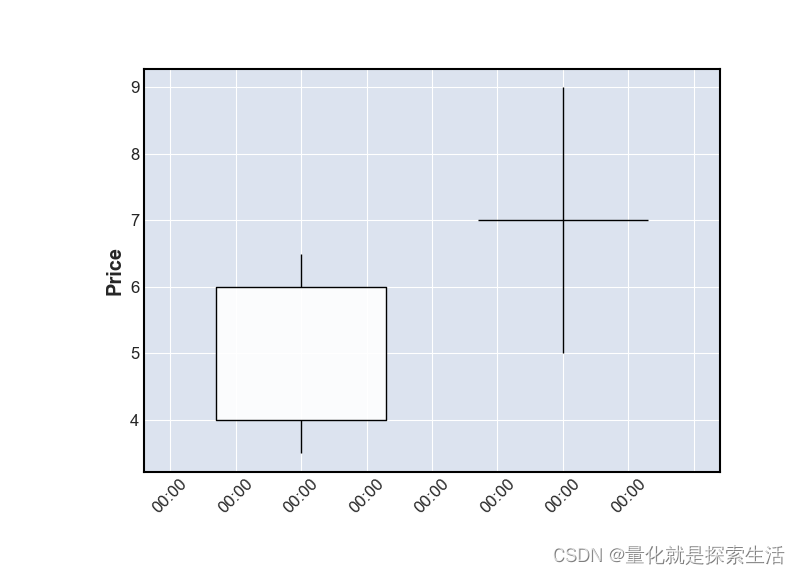
重构代码(来自ta_CDLDOJISTAR.c, 有修改, 只保留逻辑):
def CDLDOJISTAR_(open, high, low, close):
_len = len(open)
open, high, low, close = pd.Series(open), pd.Series(high), pd.Series(low), pd.Series(close)
if _len >= 12:
real_body = abs(open - close)
high_low_range = abs(high - low)
doji = high_low_range.rolling(10).mean().shift(1) * 0.1
body_long = real_body.rolling(10).mean().shift(1)
condition_1_1 = (close.shift(1) > open.shift(1)) & \
(np.maximum(close, open) > close.shift(1))
condition_1_2 = (close.shift(1) < open.shift(1)) & \
(np.minimum(close, open) < close.shift(1))
condition_2 = (real_body.shift(1) > body_long.shift(1)) & \
(real_body <= doji)
cdldojistar = np.where(condition_1_1 & condition_2, -100, 0)
cdldojistar = np.where(condition_1_2 & condition_2, 100, cdldojistar)
else:
cdldojistar = np.zeros(_len).astype(int)
return cdldojistar
CDLENGULFING (吞噬模式)
python函数原型:
cdlengulfing= CDLENGULFING(open, high, low, close)
解释:
两日K线模式,分多头吞噬和空头吞噬,以多头吞噬为例,第一日为阴线, 第二日阳线,第一日的开盘价和收盘价在第二日开盘价收盘价之内,但不能完全相同。

重构代码(来自ta_CDLENGULFING.c, 有修改, 只保留逻辑):
def CDLENGULFING_(open, high, low, close):
_len = len(open)
open, high, low, close = pd.Series(open), pd.Series(high), pd.Series(low), pd.Series(close)
if _len >= 12:
condition_1 = (close.shift(1) < open.shift(1)) & (close > open) & \
(close > open.shift(1)) & (open < close.shift(1))
condition_2 = (close.shift(1) > open.shift(1)) & (close < open) & \
(close < open.shift(1)) & (open > close.shift(1))
cdlengulfing = np.where(condition_1, 100, 0)
cdlengulfing = np.where(condition_2, -100, cdlengulfing)
else:
cdlengulfing = np.zeros(_len).astype(int)
return cdlengulfing
CDLHAMMER(锤头)
python函数原型:
cdlhammer = CDLHAMMER(open, high, low, close)
解释:
两日K线模式,第二日为长下影短上影的短实体,且实体下沿低于前一日最低价(Near)
重构代码(来自ta_CDLHAMMER.c, 有修改, 只保留逻辑):
def CDLHAMMER_(open, high, low, close):
_len = len(open)
open, high, low, close = pd.Series(open), pd.Series(high), pd.Series(low), pd.Series(close)
if _len >= 12:
condition_1 = (close.shift(1) < open.shift(1)) & (close > open) & \
(close > open.shift(1)) & (open < close.shift(1))
condition_2 = (close.shift(1) > open.shift(1)) & (close < open) & \
(close < open.shift(1)) & (open > close.shift(1))
cdlengulfing = np.where(condition_1, 100, 0)
cdlengulfing = np.where(condition_2, -100, cdlengulfing)
else:
cdlengulfing = np.zeros(_len).astype(int)
return cdlengulfing
四. 三K线模型
CDL2CROW(双乌鸦)
python函数原型:
cdl2crows= CDL2CROWS(open, high, low, close)
解释:
对于双乌鸦形状的定义,中文百科和ta-lib中定义的方式不一样,
中文百科中第一天长阳线后,第二天高开收阴, 形成缺口,第三天的大阴线包裹住第二天的阴线
ta-lib中第一根和第二跟定义相同,第三跟阴线开盘价再第二根阴线开收之间,收盘价再第一根阳线开收之间
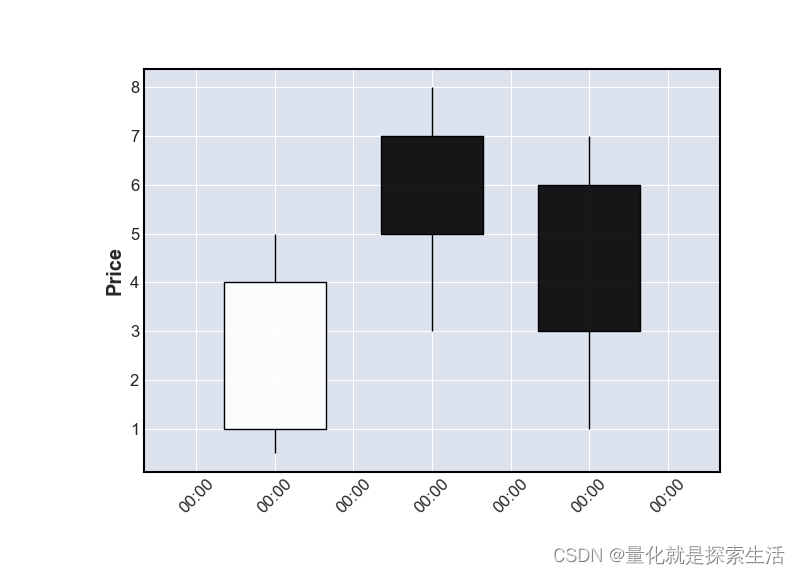
投资逻辑(仅供参考,不宜借鉴):
按照主散博弈模型,主力推高出大阳线吸引散户关注,高开吸引散户进场,主力出货一部分,再次高开吸引散户进场,主力在次出货
第一根长阳线:
O
P
E
N
−
2
−
C
L
O
S
E
−
2
>
A
V
G
(
∣
O
P
E
N
−
C
L
O
S
E
∣
)
OPEN_{-2}-CLOSE_{-2} > AVG(|OPEN-CLOSE|)
OPEN−2−CLOSE−2>AVG(∣OPEN−CLOSE∣)
第二根阴线:
O
P
E
N
−
1
>
C
L
O
S
E
−
1
>
C
L
O
S
E
−
2
OPEN_{-1} > CLOSE_{-1} > CLOSE_{-2}
OPEN−1>CLOSE−1>CLOSE−2
第三根阴线:
O
P
E
N
−
1
<
O
P
E
N
0
<
C
L
O
S
E
−
2
OPEN_{-1} < OPEN_{0} < CLOSE_{-2}
OPEN−1<OPEN0<CLOSE−2
重构代码(来自ta_CDL2CROW.c, 有修改, 只保留逻辑):
def CDL2CROWS_(open, high, low, close):
_len = len(open)
open, high, low, close = pd.Series(open), pd.Series(high), pd.Series(low), pd.Series(close)
if _len >= 13:
real_body = abs(open - close)
body_long = real_body.rolling(10).mean().shift(1)
# 第一根大阳线
condition1 = (close.shift(2) - open.shift(2)) > body_long.shift(2)
# 第二根阴线
condition2 = (open.shift(1) > close.shift(1)) & (close.shift(1) > close.shift(2))
# 第三根阴线
condition3 = (open.shift(1) > open) & (open > close.shift(1)) & \
(close.shift(2) > close) & (close > open.shift(2))
cdl2crow = np.where(condition1 & condition2 & condition3, -100, 0)
cdl2crow[:12] = 0
else:
cdl2crow = np.zeros(_len).astype(int)
return cdl2crow
CDL3BLACKCROW(三乌鸦)
python函数原型:
cdl3blackcrows= CDL3BLACKCROWS(open, high, low, close)
解释:
(1)连续三天长阴线。(ta-lib无此要求)
(2)每天的收盘出现新低。
(3)每天的开盘在前一天的实体内。
(4)每天的收盘等于或接近当天的最低。
(5)第一根阴线跌破前阳线最高点(ta-lib特有要求)
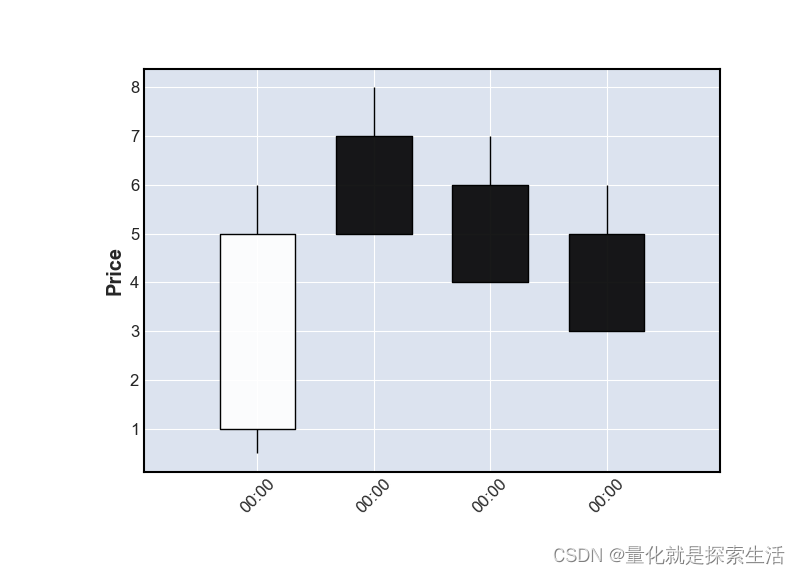
第一根阳线:
O
P
E
N
−
3
−
C
L
O
S
E
−
3
>
0
OPEN_{-3}-CLOSE_{-3} > 0
OPEN−3−CLOSE−3>0
第一根阴线:
O
P
E
N
−
2
>
C
L
O
S
E
−
2
C
L
O
S
E
−
2
<
H
I
G
H
−
3
C
L
O
S
E
−
2
−
L
O
W
−
2
<
A
V
G
(
C
L
O
S
E
−
L
O
W
)
−
2
OPEN_{-2} > CLOSE_{-2} \\ CLOSE_{-2} < HIGH_{-3} \\ CLOSE_{-2} - LOW_{-2} < AVG(CLOSE-LOW)_{-2}
OPEN−2>CLOSE−2CLOSE−2<HIGH−3CLOSE−2−LOW−2<AVG(CLOSE−LOW)−2
第二根阴线:
O
P
E
N
−
1
>
C
L
O
S
E
−
1
C
L
O
S
E
−
1
<
C
L
O
S
E
−
2
C
L
O
S
E
−
1
−
L
O
W
−
1
<
A
V
G
(
C
L
O
S
E
−
L
O
W
)
−
1
OPEN_{-1} > CLOSE_{-1} \\ CLOSE_{-1} < CLOSE_{-2} \\ CLOSE_{-1} - LOW_{-1} < AVG(CLOSE-LOW)_{-1}
OPEN−1>CLOSE−1CLOSE−1<CLOSE−2CLOSE−1−LOW−1<AVG(CLOSE−LOW)−1
第三根阴线:
O
P
E
N
0
>
C
L
O
S
E
0
C
L
O
S
E
0
<
C
L
O
S
E
−
1
C
L
O
S
E
0
−
L
O
W
0
<
A
V
G
(
C
L
O
S
E
−
L
O
W
)
0
OPEN_{0} > CLOSE_{0} \\ CLOSE_{0} < CLOSE_{-1} \\ CLOSE_{0} - LOW_{0} < AVG(CLOSE-LOW)_{0}
OPEN0>CLOSE0CLOSE0<CLOSE−1CLOSE0−LOW0<AVG(CLOSE−LOW)0
重构代码(来自ta_CDL3BLACKCROWS.c, 有修改, 只保留逻辑):
def CDL3BLACKCROWS_(open, high, low, close):
_len = len(open)
open, high, low, close = pd.Series(open), pd.Series(high), pd.Series(low), pd.Series(close)
if _len >= 14:
shadow_lower = np.minimum(close, open) - low
high_low_range = abs(high - low)
shadow_very_short = high_low_range.rolling(10).mean().shift(1) * 0.1
# 第一根阳线
condition1 = (close.shift(3) - open.shift(3)) > 0
# 第一根阴线
condition2 = (open.shift(2) > close.shift(2)) & \
(close.shift(2) < high.shift(3)) & \
(shadow_lower.shift(2) < shadow_very_short.shift(2))
# 第二根阴线
condition3 = (open.shift(1) > close.shift(1)) & \
(close.shift(1) < close.shift(2)) & \
(shadow_lower.shift(1) < shadow_very_short.shift(1))
# 第三根阴线
condition4 = (open > close) & \
(close < close.shift(1)) & \
(shadow_lower < shadow_very_short)
cdl3blackcrows = np.where(condition1 & condition2 & condition3 & condition4, -100, 0)
cdl3blackcrows[:13] = 0
else:
cdl3blackcrows = int(np.zeros(_len))
return cdl3blackcrows
CDL3INSIDE(三内部上涨和下跌)
python函数原型:
cdl2inside = CDL3INSIDE(open, high, low, close)
解释:
- 母子信号是该信号的主要组成部分。第一天包裹第二天
- 母蜡烛的颜色应当与长蜡烛日的颜色相反。
- 如果趋势表明为上涨,则第三天的收盘价高于第一天的开盘价;否则,第三天的收盘价会低于第一天的开盘价。
以下四种情况皆会产生信号(四种情况,一二涨,三四跌)
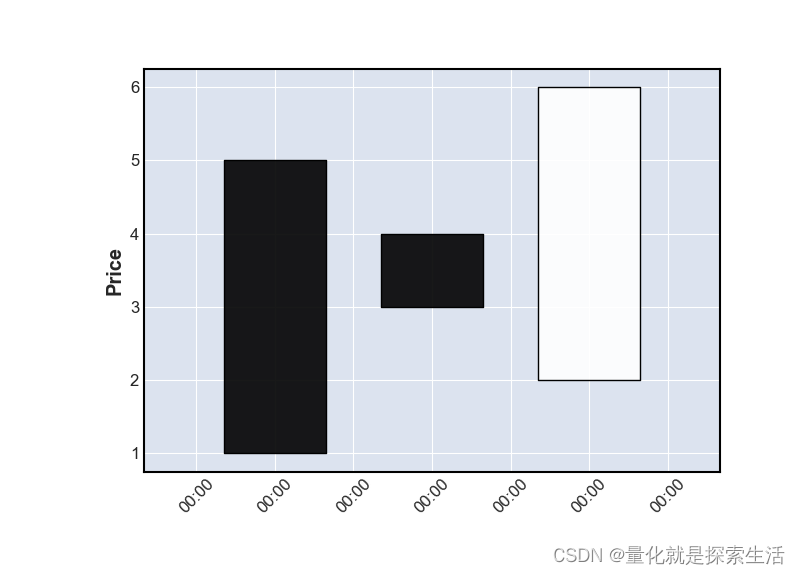
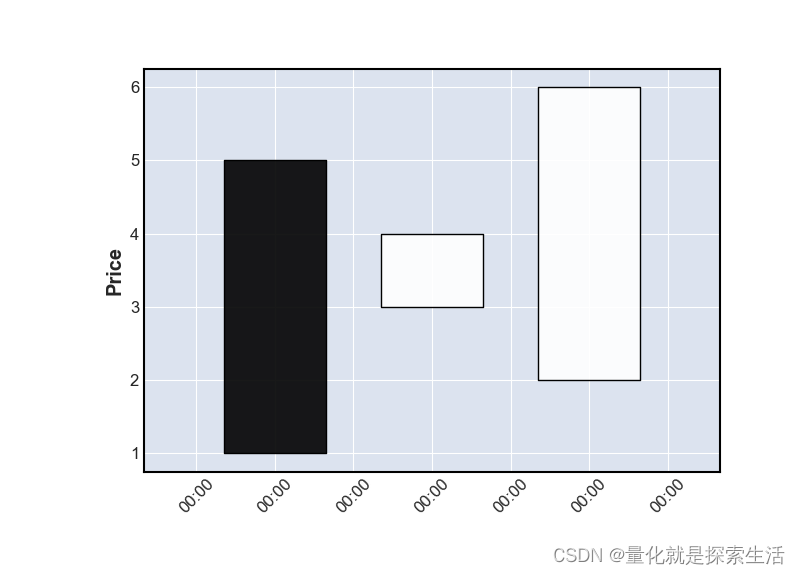

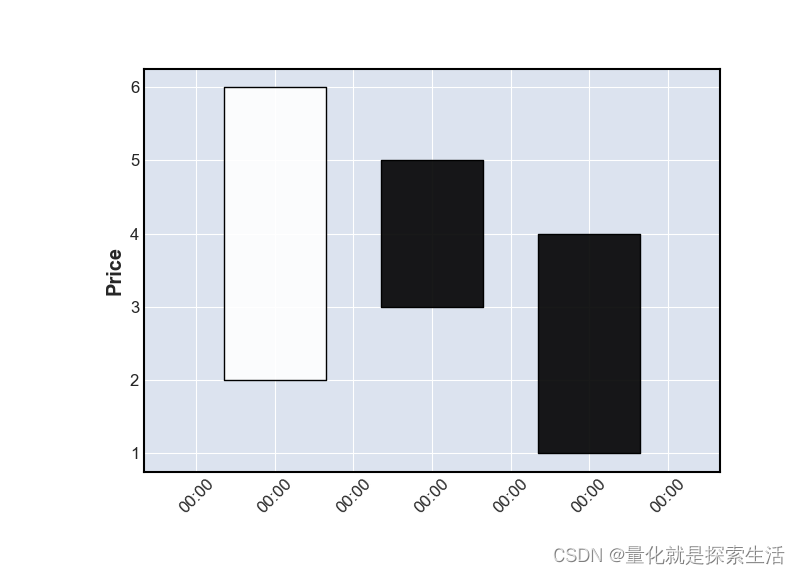
三内部上涨
第一根阴线:
O
P
E
N
−
2
−
C
L
O
S
E
−
2
>
A
V
G
(
∣
O
P
E
N
−
C
L
O
S
E
∣
)
OPEN_{-2}-CLOSE_{-2} > AVG(|OPEN-CLOSE|)
OPEN−2−CLOSE−2>AVG(∣OPEN−CLOSE∣)
第二根线:
∣
O
P
E
N
−
1
−
C
L
O
S
E
−
1
∣
<
A
V
G
(
∣
O
P
E
N
−
C
L
O
S
E
∣
)
m
a
x
(
O
P
E
N
−
1
,
C
L
O
S
E
−
1
)
<
O
P
E
N
−
2
m
i
n
(
O
P
E
N
−
1
,
C
L
O
S
E
−
1
)
>
C
L
O
S
E
−
2
|OPEN_{-1} - CLOSE_{-1}| < AVG(|OPEN-CLOSE|) \\ max(OPEN_{-1}, CLOSE_{-1}) < OPEN_{-2} \\ min(OPEN_{-1}, CLOSE_{-1}) > CLOSE_{-2} \\
∣OPEN−1−CLOSE−1∣<AVG(∣OPEN−CLOSE∣)max(OPEN−1,CLOSE−1)<OPEN−2min(OPEN−1,CLOSE−1)>CLOSE−2
第三根阳线:
O
P
E
N
<
C
L
O
S
E
C
L
O
S
E
>
O
P
E
N
−
2
OPEN < CLOSE \\ CLOSE > OPEN_{-2} \\
OPEN<CLOSECLOSE>OPEN−2
三内部下跌
第一根阳线:
C
L
O
S
E
−
2
−
O
P
E
N
−
2
>
A
V
G
(
∣
O
P
E
N
−
C
L
O
S
E
∣
)
CLOSE_{-2}-OPEN_{-2} > AVG(|OPEN-CLOSE|)
CLOSE−2−OPEN−2>AVG(∣OPEN−CLOSE∣)
第二根线:
∣
O
P
E
N
−
1
−
C
L
O
S
E
−
1
∣
<
A
V
G
(
∣
O
P
E
N
−
C
L
O
S
E
∣
)
m
a
x
(
O
P
E
N
−
1
,
C
L
O
S
E
−
1
)
<
C
L
O
S
E
−
2
m
i
n
(
O
P
E
N
−
1
,
C
L
O
S
E
−
1
)
>
O
P
E
N
−
2
|OPEN_{-1} - CLOSE_{-1}| < AVG(|OPEN-CLOSE|) \\ max(OPEN_{-1}, CLOSE_{-1}) < CLOSE_{-2} \\ min(OPEN_{-1}, CLOSE_{-1}) > OPEN_{-2} \\
∣OPEN−1−CLOSE−1∣<AVG(∣OPEN−CLOSE∣)max(OPEN−1,CLOSE−1)<CLOSE−2min(OPEN−1,CLOSE−1)>OPEN−2
第三根阳线:
O
P
E
N
>
C
L
O
S
E
C
L
O
S
E
<
O
P
E
N
−
2
OPEN > CLOSE \\ CLOSE < OPEN_{-2} \\
OPEN>CLOSECLOSE<OPEN−2
重构代码(来自ta_CDL3INSIDE.c, 有修改, 只保留逻辑):
def CDL3INSIDE_(open, high, low, close):
_len = len(open)
open, high, low, close = pd.Series(open), pd.Series(high), pd.Series(low), pd.Series(close)
if _len >= 13:
body_long = abs(open - close)
avg_body_long = body_long.rolling(10).mean().shift(1)
# 第一根母线
condition1 = abs(close.shift(2) - open.shift(2)) > avg_body_long.shift(2)
# 第二根子线
condition2 = (abs(close.shift(1) - open.shift(1)) <= avg_body_long.shift(1)) & \
(np.maximum(close.shift(1), open.shift(1)) < np.maximum(close.shift(2), open.shift(2))) & \
(np.minimum(close.shift(1), open.shift(1)) > np.minimum(close.shift(2), open.shift(2)))
# 第三根长阴线
condition3_1 = (close.shift(2) > open.shift(2)) & (close < open) & (close < open.shift(2))
# 第三根长阳线
condition3_2 = (close.shift(2) < open.shift(2)) & (close > open) & (close > open.shift(2))
cdl3inside = np.where(condition1 & condition2 & condition3_1, -100, 0)
cdl3inside = np.where(condition1 & condition2 & condition3_2, 100, cdl3inside)
cdl3inside[:12] = 0
else:
cdl3inside = np.zeros(_len).astype(int)
return cdl3inside
CDL3OUTSIDE(三外部上涨和下跌)
python函数原型:
cdl2outside = CDL3OUTSIDE(open, high, low, close)
解释:
- 母子信号是该信号的主要组成部分,第一天包裹第二天
- 第一日和第二日的颜色相反
- 如果趋势表明为上涨,则第三天的收盘价高于第一天的开盘价;否则,第三天的收盘价会低于第一天的开盘价。
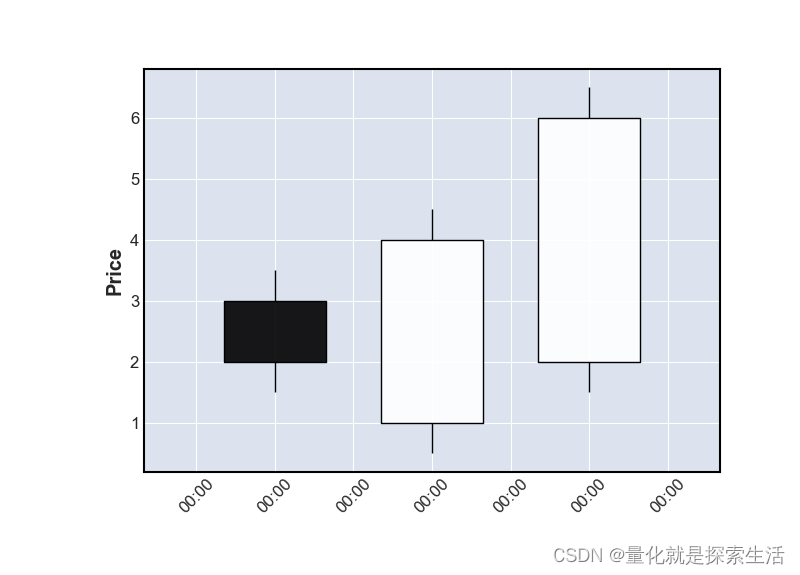
三外部上涨(下跌同理)
第一根阴线:
O
P
E
N
−
2
>
C
L
O
S
E
−
2
OPEN_{-2}>CLOSE_{-2}
OPEN−2>CLOSE−2
第二根阳线:
O
P
E
N
−
1
<
C
L
O
S
E
−
1
C
L
O
S
E
−
1
>
O
P
E
N
−
2
O
P
E
N
−
1
<
C
L
O
S
E
−
2
OPEN_{-1}<CLOSE_{-1} \\ CLOSE_{-1}>OPEN_{-2} \\ OPEN_{-1}<CLOSE_{-2} \\
OPEN−1<CLOSE−1CLOSE−1>OPEN−2OPEN−1<CLOSE−2
第三根阳线:
C
L
O
S
E
<
C
L
O
S
E
−
1
CLOSE < CLOSE_{-1}
CLOSE<CLOSE−1
重构代码(来自ta_CDL3OUTSIDE.c, 有修改, 只保留逻辑):
def CDL3OUTSIDE_(open, high, low, close):
_len = len(open)
open, high, low, close = pd.Series(open), pd.Series(high), pd.Series(low), pd.Series(close)
if _len >= 4:
# 第一根子线阳
condition_1_1 = close.shift(2) > open.shift(2)
# 第二根母线阴
condition_1_2 = (open.shift(1) > close.shift(1)) & \
(close.shift(1) < open.shift(2)) & \
(open.shift(1) > close.shift(2))
# 第三根阴线
condition_1_3 = (close < close.shift(1))
cdl3outside = np.where(condition_1_1 & condition_1_2
& condition_1_3, -100, 0)
# 第一根子线阳
condition_2_1 = close.shift(2) < open.shift(2)
# 第二根母线阴
condition_2_2 = (open.shift(1) < close.shift(1)) & \
(close.shift(1) > open.shift(2)) & \
(open.shift(1) < close.shift(2))
# 第三根阴线
condition_2_3 = (close > close.shift(1))
cdl3outside = np.where(condition_2_1 & condition_2_2
& condition_2_3, 100, cdl3outside)
cdl3outside[:3] = 0
else:
cdl3outside = np.zeros(_len).astype(int)
return cdl3outside
CDL3STARSINSOUTH (南方三星)
python函数原型:
cdl3starsinsouth = CDL3STARSINSOUTH(open, high, low, close)
解释:
(1)三天连续阴线
(2)第一天大阴线且有较长的大影线
(3)第二天开盘位于前一天实体内,收盘位于前一天下影线内,且实体短于前一天
(4)第三天上下影线特别短(veryshort),实体短(bodyshort)且位于前一天的high,low之间
(5)见底信号
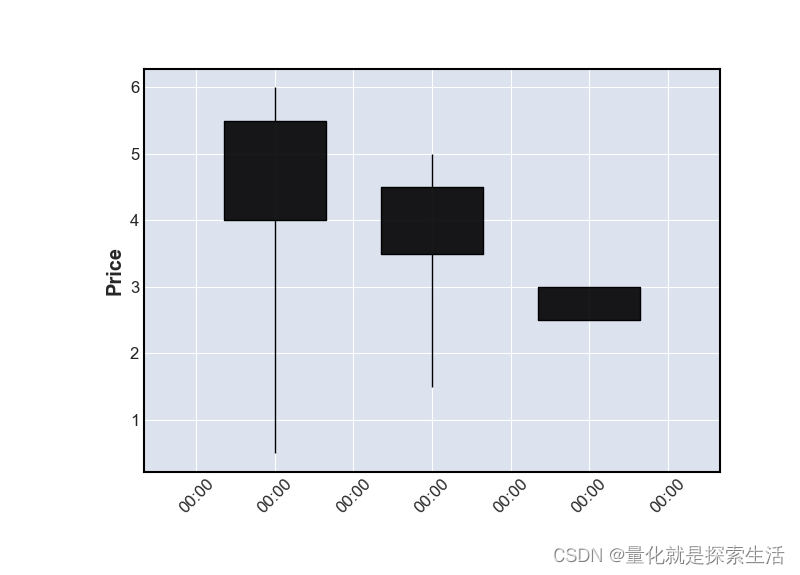
第一根阴线:
C
L
O
S
E
−
2
<
O
P
E
N
−
2
O
P
E
N
−
2
−
C
L
O
S
E
−
2
>
A
V
G
(
∣
C
L
O
S
E
−
O
P
E
N
∣
)
C
L
O
S
E
−
2
−
L
O
W
−
2
>
B
O
D
Y
_
L
O
N
G
−
2
CLOSE_{-2} < OPEN_{-2} \\ OPEN_{-2}-CLOSE{-2} > AVG(|CLOSE-OPEN|) \\ CLOSE_{-2}-LOW_{-2} > BODY\_LONG_{-2}
CLOSE−2<OPEN−2OPEN−2−CLOSE−2>AVG(∣CLOSE−OPEN∣)CLOSE−2−LOW−2>BODY_LONG−2
第二根阴线:
C
L
O
S
E
−
1
<
O
P
E
N
−
1
O
P
E
N
−
1
−
C
L
O
S
E
−
1
<
C
L
O
S
E
−
1
−
O
P
E
N
−
1
C
L
O
S
E
−
2
<
O
P
E
N
−
1
<
=
H
I
G
H
−
2
L
O
W
−
2
<
=
L
O
W
−
1
<
C
L
O
S
E
−
2
C
L
O
S
E
−
1
−
L
O
W
−
1
>
S
H
A
D
O
W
_
V
E
R
Y
_
S
H
O
R
T
−
1
CLOSE_{-1} < OPEN_{-1} \\ OPEN_{-1}-CLOSE{-1} < CLOSE_{-1} - OPEN_{-1} \\ CLOSE_{-2} < OPEN_{-1} <= HIGH_{-2} \\ LOW_{-2} <= LOW_{-1} < CLOSE_{-2} \\ CLOSE_{-1}-LOW_{-1} >SHADOW\_VERY\_SHORT_{-1}
CLOSE−1<OPEN−1OPEN−1−CLOSE−1<CLOSE−1−OPEN−1CLOSE−2<OPEN−1<=HIGH−2LOW−2<=LOW−1<CLOSE−2CLOSE−1−LOW−1>SHADOW_VERY_SHORT−1
第三根阴线:
C
L
O
S
E
<
O
P
E
N
O
P
E
N
−
C
L
O
S
E
>
B
O
D
Y
_
S
H
O
R
T
H
I
G
H
−
O
P
E
N
<
S
H
A
D
O
W
_
V
E
R
Y
_
S
H
O
R
T
C
L
O
S
E
−
L
O
W
<
S
H
A
D
O
W
_
V
E
R
Y
_
S
H
O
R
T
L
O
W
>
L
O
W
−
1
H
I
G
H
<
H
I
G
H
−
1
CLOSE<OPEN \\ OPEN-CLOSE > BODY\_SHORT \\ HIGH-OPEN < SHADOW\_VERY\_SHORT \\ CLOSE-LOW < SHADOW\_VERY\_SHORT \\ LOW > LOW_{-1} \\ HIGH < HIGH_{-1}
CLOSE<OPENOPEN−CLOSE>BODY_SHORTHIGH−OPEN<SHADOW_VERY_SHORTCLOSE−LOW<SHADOW_VERY_SHORTLOW>LOW−1HIGH<HIGH−1
重构代码(来自ta_CDL3STARSINSOUTH.c, 有修改, 只保留逻辑):
def CDL3STARSINSOUTH_(open, high, low, close):
_len = len(open)
open, high, low, close = pd.Series(open), pd.Series(high), pd.Series(low), pd.Series(close)
if _len >= 13:
real_body = abs(open - close)
avg_body_long = real_body.rolling(10).mean().shift(1)
body_short = real_body.rolling(10).mean().shift(1) * 0.5
shadow_lower = np.minimum(close, open) - low
high_low_range_10per = (high - low) * 0.1
shadow_very_short = high_low_range_10per.rolling(10).mean().shift(1)
shadow_upper = high - np.maximum(close, open)
# 第一根阴线
condition_1 = (close.shift(2) < open.shift(2)) & (real_body.shift(2) > avg_body_long.shift(2)) & \
(shadow_lower.shift(2) > 2 * real_body.shift(2))
# 第二根阴线
condition_2 = (close.shift(1) < open.shift(1)) & (real_body.shift(1) < real_body.shift(2)) & \
(open.shift(1) > close.shift(2)) & (open.shift(1) <= high.shift(2)) & \
(low.shift(1) < close.shift(2)) & (low.shift(1) >= low.shift(2)) & \
(shadow_lower.shift(1) > shadow_very_short.shift(1))
# 第三根阴线
condition_3 = (close < open) & (real_body < body_short) & \
(shadow_lower < shadow_very_short) & (shadow_upper < shadow_very_short) & \
(low > low.shift(1)) & (high < high.shift(1))
cdl3starsinsouth = np.where(condition_1 & condition_2 & condition_3, 100, 0)
else:
cdl3starsinsouth = np.zeros(_len).astype(int)
return cdl3starsinsouth
CDL3WHITESOLDIERS (三白兵)
python函数原型:
cdl3whitesoldiers = CDL3WHITESOLDIERS(open, high, low, close)
解释:
(1)三天连续阳线
(2)三天上影线非常短
(3)开盘价接近(near)前一日实体之内
(4)后一日实体不比前一日小很多(far)
(5)最后一日实体不短(bodyshort)
示意图:

第一日阳线:
C
L
O
S
E
−
2
>
O
P
E
N
−
2
S
H
A
D
O
W
_
U
P
P
E
R
−
2
>
S
H
A
D
O
W
_
V
E
R
Y
_
S
H
O
R
T
−
2
CLOSE_{-2} > OPEN_{-2} \\ SHADOW\_UPPER_{-2} > SHADOW\_VERY\_SHORT_{-2}
CLOSE−2>OPEN−2SHADOW_UPPER−2>SHADOW_VERY_SHORT−2
第二日阳线:
C
L
O
S
E
−
1
>
O
P
E
N
−
1
S
H
A
D
O
W
_
U
P
P
E
R
−
1
>
S
H
A
D
O
W
_
V
E
R
Y
_
S
H
O
R
T
−
1
C
L
O
S
E
−
1
>
C
L
O
S
E
−
2
O
P
E
N
−
1
>
O
P
E
N
−
2
O
P
E
N
−
1
<
=
C
L
O
S
E
−
2
+
N
E
A
R
R
E
A
L
_
B
O
D
Y
−
1
>
R
E
A
L
_
B
O
D
Y
−
2
−
F
A
R
CLOSE_{-1} > OPEN_{-1} \\ SHADOW\_UPPER_{-1} > SHADOW\_VERY\_SHORT_{-1} \\ CLOSE_{-1} > CLOSE_{-2} \\ OPEN_{-1} > OPEN_{-2} \\ OPEN_{-1} <= CLOSE_{-2} + NEAR \\ REAL\_BODY_{-1} > REAL\_BODY_{-2} - FAR
CLOSE−1>OPEN−1SHADOW_UPPER−1>SHADOW_VERY_SHORT−1CLOSE−1>CLOSE−2OPEN−1>OPEN−2OPEN−1<=CLOSE−2+NEARREAL_BODY−1>REAL_BODY−2−FAR
第三日阳线:
C
L
O
S
E
>
O
P
E
N
S
H
A
D
O
W
_
U
P
P
E
R
>
S
H
A
D
O
W
_
V
E
R
Y
_
S
H
O
R
T
C
L
O
S
E
>
C
L
O
S
E
−
1
O
P
E
N
>
O
P
E
N
−
1
O
P
E
N
<
=
C
L
O
S
E
−
1
+
N
E
A
R
R
E
A
L
_
B
O
D
Y
>
R
E
A
L
_
B
O
D
Y
−
1
−
F
A
R
R
E
A
L
_
B
O
D
Y
>
B
O
D
Y
_
S
H
O
R
T
CLOSE > OPEN \\ SHADOW\_UPPER > SHADOW\_VERY\_SHORT \\ CLOSE > CLOSE_{-1} \\ OPEN > OPEN_{-1} \\ OPEN <= CLOSE_{-1} + NEAR \\ REAL\_BODY > REAL\_BODY_{-1} - FAR \\ REAL\_BODY > BODY\_SHORT
CLOSE>OPENSHADOW_UPPER>SHADOW_VERY_SHORTCLOSE>CLOSE−1OPEN>OPEN−1OPEN<=CLOSE−1+NEARREAL_BODY>REAL_BODY−1−FARREAL_BODY>BODY_SHORT
重构代码(来自ta_CDL3LINESTRKE.c, 有修改, 只保留逻辑):
def CDL3WHITESOLDIERS_(open, high, low, close):
_len = len(open)
open, high, low, close = pd.Series(open), pd.Series(high), pd.Series(low), pd.Series(close)
if _len >= 13:
real_body = abs(open - close)
body_short = real_body.rolling(10).mean().shift(1) * 0.5
high_low_range_10per = (high - low) * 0.1
shadow_very_short = high_low_range_10per.rolling(10).mean().shift(1)
shadow_upper = high - np.maximum(close, open)
high_low_range_20per = (high - low) * 0.2
high_low_range_60per = (high - low) * 0.6
near = high_low_range_20per.rolling(5).mean().shift(1)
far = high_low_range_60per.rolling(5).mean().shift(1)
# 第一根阳线
condition_1 = (close.shift(2) > open.shift(2)) & (shadow_upper.shift(2) < shadow_very_short.shift(2))
# 第二根阳线
condition_2 = (close.shift(1) > open.shift(1)) & (shadow_upper.shift(1) < shadow_very_short.shift(1)) & \
(close.shift(1) > close.shift(2)) & (open.shift(1) > open.shift(2)) & \
(open.shift(1) <= close.shift(2) + near.shift(2)) & \
(real_body.shift(1) > real_body.shift(2) - far.shift(2))
# 第三根阳线
condition_3 = (close > open) & (shadow_upper < shadow_very_short) & (close > close.shift(1)) & \
(open > open.shift(1)) & (open <= close.shift(1) + near.shift(1)) & \
(real_body > real_body.shift(1) - far.shift(1)) & \
(real_body > body_short)
cdl3whitesoldiers = np.where(condition_1 & condition_2 & condition_3, 100, 0)
else:
cdl3whitesoldiers = np.zeros(_len).astype(int)
return cdl3whitesoldiers
CDLABANDONEDBABY(弃婴)
python函数原型:
cdlabandonedbaby = CDLABANDONEDBABY(open, high, low, close, penetration=0.3)
解释:
(1)三天K线,若第一日涨
(2)第二日跳空高开且收十字星
(3)第三日低开收阴
(4)预示反转
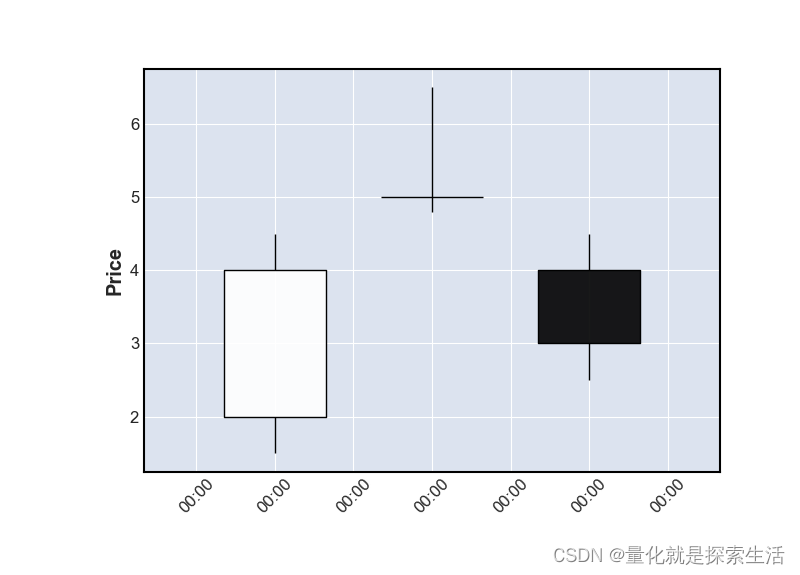
顶部为例:
第一根阳线:
C
L
O
S
E
−
2
>
O
P
E
N
−
2
R
E
A
L
_
B
O
D
Y
−
2
>
B
O
D
Y
_
L
O
N
G
−
2
CLOSE_{-2} > OPEN_{-2} \\ REAL\_BODY_{-2} > BODY\_LONG_{-2}
CLOSE−2>OPEN−2REAL_BODY−2>BODY_LONG−2
第二根上缺口:
R
E
A
L
_
B
O
D
Y
−
1
<
=
B
O
D
Y
_
D
O
J
I
−
1
L
O
W
−
1
>
H
I
G
H
−
2
REAL\_BODY_{-1} <= BODY\_DOJI_{-1} \\ LOW_{-1} > HIGH_{-2}
REAL_BODY−1<=BODY_DOJI−1LOW−1>HIGH−2
第三跟阴线:
C
L
O
S
E
>
O
P
E
N
R
E
A
L
_
B
O
D
Y
>
B
O
D
Y
_
L
O
N
G
C
L
O
S
E
<
C
L
O
S
E
−
2
−
R
E
A
L
_
B
O
D
Y
−
2
×
P
E
N
E
T
R
A
T
I
O
N
L
O
W
−
1
>
H
I
G
H
CLOSE > OPEN \\ REAL\_BODY > BODY\_LONG \\ CLOSE < CLOSE_{-2} - REAL\_BODY_{-2} \times PENETRATION \\ LOW_{-1} > HIGH
CLOSE>OPENREAL_BODY>BODY_LONGCLOSE<CLOSE−2−REAL_BODY−2×PENETRATIONLOW−1>HIGH
重构代码(来自ta_CDLABANDONEDBABY.c, 有修改, 只保留逻辑):
def CDLABANDONEDBABY_(open, high, low, close, penetration=0.3):
_len = len(open)
open, high, low, close = pd.Series(open), pd.Series(high), pd.Series(low), pd.Series(close)
if _len >= 13:
real_body = abs(open - close)
body_short = real_body.rolling(10).mean().shift(1) * 0.5
body_long = real_body.rolling(10).mean().shift(1)
body_doji = real_body.rolling(10).mean().shift(1) * 0.1
# 第一根阳线
condition_1_1 = (close.shift(2) > open.shift(2)) & (real_body.shift(2) > body_long.shift(2))
# 第二根上缺口
condition_1_2 = (real_body.shift(1) <= body_doji.shift(1)) & \
(low.shift(1) > high.shift(2))
# 第三根阴线
condition_1_3 = (close < open) & (real_body > body_short) & \
(close < close.shift(2) - real_body.shift(2) * penetration) & \
(low.shift(1) > high)
cdl3abandonbaby = np.where(condition_1_1 & condition_1_2 & condition_1_3, -100, 0)
# 第一根阳线
condition_2_1 = (close.shift(2) < open.shift(2)) & (real_body.shift(2) > body_long.shift(2))
# 第二根上缺口
condition_2_2 = (real_body.shift(1) <= body_doji.shift(1)) & \
(high.shift(1) < low.shift(2))
# 第三根阴线
condition_2_3 = (close > open) & (real_body > body_short) & \
(close > close.shift(2) + real_body.shift(2) * penetration) & \
(high.shift(1) < low)
cdl3abandonbaby = np.where(condition_2_1 & condition_2_2 & condition_2_3, 100, cdl3abandonbaby)
else:
cdl3abandonbaby = np.zeros(_len).astype(int)
return cdl3abandonbaby
CDLADVANCEBLOCK(大敌当前)
python函数原型:
cdladvanceblock = = CDLADVANCEBLOCK(open, high, low, close)
百科解释:三日K线模式,三日都收阳,每日收盘价都比前一日高, 开盘价都在前一日实体以内,实体变短,上影线变长。
talib中定义了四种满足advanceblock的条件
公共条件:
- 三练阳,收盘价逐日往上
- 三日开盘价高于前一日开盘价,不超过(near)前一日收盘价
- 首日长实体(body_long),短上影线(shadow_short)
情况1:上升阻碍由于第二根bar的短实体
- 第二日实体远短于(far)第一日实体
- 第三日实体不长于(near)第二日实体
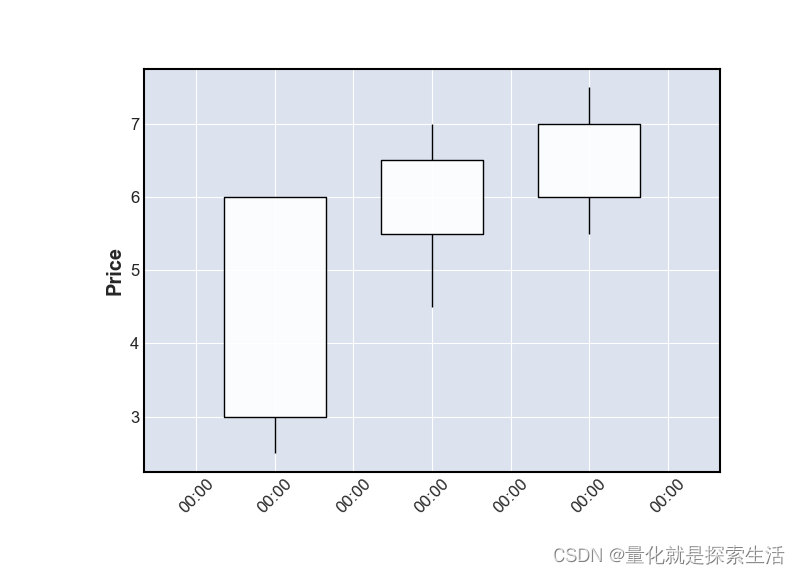
R E A L _ B O D Y − 1 < R E A L _ B O D Y − 2 − F a r − 2 R E A L _ B O D Y 0 < R E A L _ B O D Y − 1 + N e a r − 1 REAL\_BODY_{-1} < REAL\_BODY_{-2} - Far_{-2} \\ REAL\_BODY_{0} < REAL\_BODY_{-1} + Near_{-1} REAL_BODY−1<REAL_BODY−2−Far−2REAL_BODY0<REAL_BODY−1+Near−1
情况2:上升阻碍由于第三根bar的短实体
- 第三日实体远短于(far)第二日实体
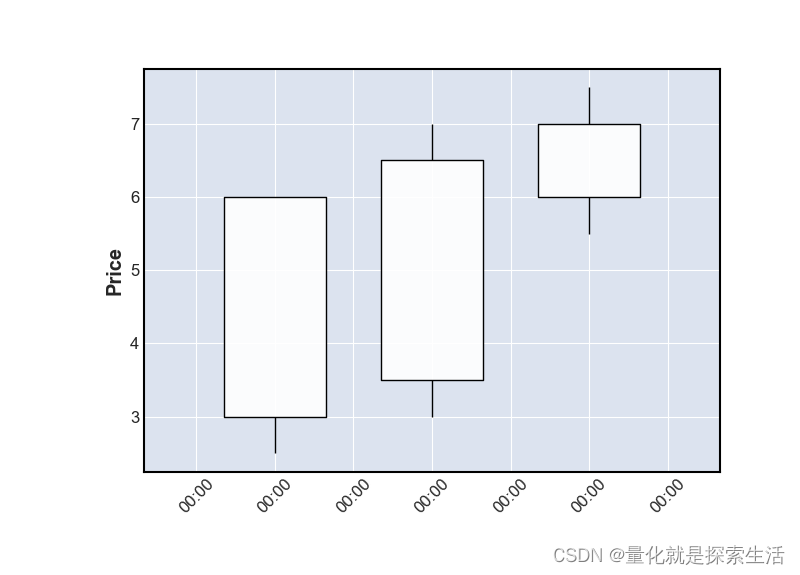
R E A L _ B O D Y 0 < R E A L _ B O D Y − 1 − F a r − 1 REAL\_BODY_{0} < REAL\_BODY_{-1} - Far_{-1} REAL_BODY0<REAL_BODY−1−Far−1
情况3:上升阻碍由于逐渐变短的实体和不短的上影线
- 第三根实体小于第二根,第二根实体小于第一根
- 第三根或第二根上影线不短(shadow_short)
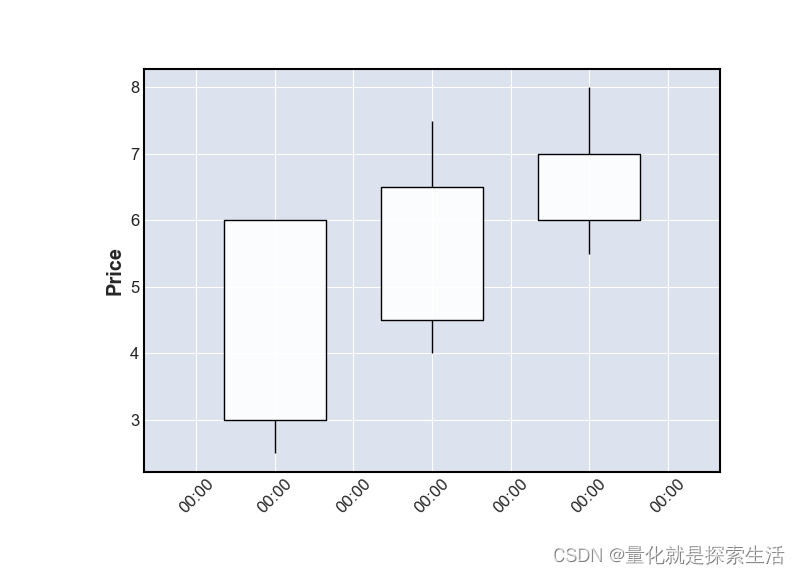
R E A L _ B O D Y − 1 < R E A L _ B O D Y − 2 R E A L _ B O D Y 0 < R E A L _ B O D Y − 1 ( S H A D O W _ U P P E R 0 > S H A D O W _ S H O R T 0 ) o r ( S H A D O W _ U P P E R − 1 > S H A D O W _ S H O R T − 1 ) REAL\_BODY_{-1} < REAL\_BODY_{-2} \\ REAL\_BODY_{0} < REAL\_BODY_{-1} \\ (SHADOW\_UPPER_{0} > SHADOW\_SHORT_{0})\ or \\ (SHADOW\_UPPER_{-1} > SHADOW\_SHORT_{-1}) REAL_BODY−1<REAL_BODY−2REAL_BODY0<REAL_BODY−1(SHADOW_UPPER0>SHADOW_SHORT0) or(SHADOW_UPPER−1>SHADOW_SHORT−1)
情况4:上升阻碍由于第三根较短的实体和长上影线
- 第三根实体小于第二根
- 第三根上影线长(shadow_long)

R E A L _ B O D Y 0 < R E A L _ B O D Y − 1 S H A D O W _ U P P E R 0 > S H A D O W _ L O N G 0 REAL\_BODY_{0} < REAL\_BODY_{-1} \\ SHADOW\_UPPER_{0} > SHADOW\_LONG_{0} REAL_BODY0<REAL_BODY−1SHADOW_UPPER0>SHADOW_LONG0
重构代码(来自ta_CDL3LINESTRKE.c, 有修改, 只保留逻辑):
def CDLADVANCEBLOCK_(open, high, low, close):
_len = len(open)
open, high, low, close = pd.Series(open), pd.Series(high), pd.Series(low), pd.Series(close)
if _len >= 13:
real_body = abs(open - close)
body_long = real_body.rolling(10).mean().shift(1)
high_low_range = high - low
near = high_low_range.rolling(5).mean().shift(1) * 0.2
far = high_low_range.rolling(5).mean().shift(1) * 0.6
shadow_upper = high - np.maximum(close, open)
shadow_lower = np.minimum(close, open) - low
shadow_short = (shadow_upper + shadow_lower).rolling(10).mean().shift(1) * 0.5
common_condition = (close.shift(2) > open.shift(2)) & (close.shift(1) > open.shift(1)) & \
(close > open) & (close > close.shift(1)) & (close.shift(1) > close.shift(2)) & \
(open.shift(1) > open.shift(2)) & (open.shift(1) <= close.shift(2) + near.shift(2)) & \
(open > open.shift(1)) & (open < close.shift(1) + near.shift(1)) & \
(real_body.shift(2) > body_long.shift(2)) & (shadow_upper.shift(2) < shadow_short.shift(2))
# 第二根远小于第一根, 第三根不长于第二根
# 上升阻碍在第二根bar,第三根不得阻碍
condition_1 = (real_body.shift(1) < real_body.shift(2) - far.shift(2)) & \
(real_body < real_body.shift(1) + near.shift(1))
# 第三更远小于第二根
# 上升阻碍在第三根bar
condition_2 = (real_body < real_body.shift(1) - far.shift(1))
# 第三根小于第二根,第二根小于第一根, 第三和第二根不具有长上影线
# 上升阻碍在逐渐变小地上影线和实体
condition_3 = (real_body.shift(1) < real_body.shift(2)) & (real_body < real_body.shift(1)) & \
(shadow_upper > shadow_short) & (shadow_upper.shift(1) > shadow_short.shift(1))
# 第三根小于第二根, 第三根有很长地上影线
# 上升阻碍在第三根长上影线和短实体
condition_4 = (real_body < real_body.shift(1)) & (shadow_upper > real_body)
cdladvanceblock = np.where(common_condition & (condition_1 | condition_2 | condition_3 | condition_4), -100, 0)
else:
cdladvanceblock = np.zeros(_len).astype(int)
return cdladvanceblock
CDLEVENINGDOJISTAR (十字暮星)
python函数原型:
cdleveningdojistar = CDLEVENINGDOJISTAR (open, high, low, close, penetration=0.3)
解释:
与CDLABANDONEDBABY(弃婴)非常相似,缺口放宽至实体缺口
- 第一日大阳线
- 第二日高开十字线
- 第三日大阴线,收盘小于第一根实体的30%分位数

重构代码(来自ta_CDLEVENINGDOJISTAR.c, 有修改, 只保留逻辑):
def CDLEVENINGDOJISTAR_(open, high, low, close, penetration=0.3):
_len = len(open)
open, high, low, close = pd.Series(open), pd.Series(high), pd.Series(low), pd.Series(close)
if _len >= 13:
real_body = abs(open - close)
body_long = real_body.rolling(10).mean().shift(1)
high_low_range = high - low
doji = high_low_range.rolling(10).mean().shift(1) * 0.1
condition_1 = (real_body.shift(2) > body_long.shift(2)) & \
(close.shift(2) > open.shift(2))
condition_2 = (real_body.shift(1) < doji.shift(1)) & \
(np.minimum(close.shift(1), open.shift(1)) > close.shift(2))
condition_3 = (real_body > body_long) & \
(close < open) & \
(close < close.shift(2) - real_body.shift(2) * penetration)
cdleveningdojistar = np.where(condition_1 & condition_2 & condition_3, -100, 0)
else:
cdleveningdojistar = np.zeros(_len).astype(int)
return cdleveningdojistar
CDLEVENINGSTAR (暮星)
python函数原型:
cdleveningstar= CDLEVENINGSTAR (open, high, low, close, penetration=0.3)
与CDLEVENINGDOJISTAR (十字暮星)非常相似,十字线放宽至短线
- 第一日大阳线
- 第二日高开短线
- 第三日大阴线,收盘小于第一根实体的30%分位数
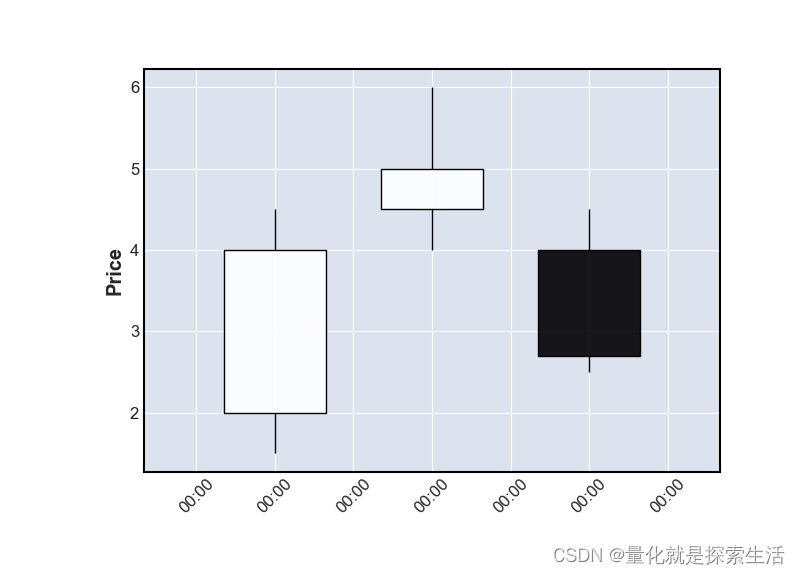
重构代码(来自ta_CDLEVENINGSTAR.c, 有修改, 只保留逻辑):
def CDLEVENINGSTAR_(open, high, low, close, penetration=0.3):
_len = len(open)
open, high, low, close = pd.Series(open), pd.Series(high), pd.Series(low), pd.Series(close)
if _len >= 13:
real_body = abs(open - close)
body_long = real_body.rolling(10).mean().shift(1)
condition_1 = (real_body.shift(2) > body_long.shift(2)) & \
(close.shift(2) > open.shift(2))
condition_2 = (real_body.shift(1) <= body_long.shift(1)) & \
(np.minimum(close.shift(1), open.shift(1)) > close.shift(2))
condition_3 = (real_body > body_long) & \
(close < open) & \
(close < close.shift(2) - real_body.shift(2) * penetration)
cdleveningstar = np.where(condition_1 & condition_2 & condition_3, -100, 0)
else:
cdleveningstar = np.zeros(_len).astype(int)
return cdleveningstar
CDLGAPSIDESIDEWHITE (向上/下跳空并列阳线)
python函数原型:
cdlgapsidesidewhite = CDLGAPSIDESIDEWHITE(open, high, low, close)
解释:
向上或向下跳空后,两根并列(equal)几乎等长(Near)的阳线
趋势方向为跳空方向
三连阴情况类似
重构代码(来自ta_CDLGAPSIDESIDEWHITE.c, 有修改, 只保留逻辑):
def CDLGAPSIDESIDEWHITE_(open, high, low, close):
_len = len(open)
open, high, low, close = pd.Series(open), pd.Series(high), pd.Series(low), pd.Series(close)
if _len >= 13:
real_body = abs(open - close)
high_low_range = high - low
near = high_low_range.rolling(5).mean().shift(1) * 0.2
equal = high_low_range.rolling(5).mean().shift(1) * 0.05
# 向上跳空
condition_1_1 = np.maximum(close.shift(2), open.shift(2)) < np.minimum(open.shift(1), open)
# 向下跳空
condition_1_2 = np.minimum(close.shift(2), open.shift(2)) > np.minimum(close.shift(1), close)
condition_2 = (close.shift(1) > open.shift(1)) & \
(close > open)
condition_3 = (real_body <= real_body.shift(1) + near.shift(1)) & \
(real_body >= real_body.shift(1) - near.shift(1)) & \
(open <= open.shift(1) + equal.shift(1)) & \
(open >= open.shift(1) - equal.shift(1))
cdlgapsidesidewhite = np.where(condition_1_1 & condition_2 & condition_3, 100, 0)
cdlgapsidesidewhite = np.where(condition_1_2 & condition_2 & condition_3, -100, cdlgapsidesidewhite)
else:
cdlgapsidesidewhite = np.zeros(_len).astype(int)
return cdlgapsidesidewhite
五. 四K线模型
CDL3LINESTRIKE(三线打击)
python函数原型:
cdl3linestrike = CDL3LINESTRIKE(open, high, low, close)
解释:
(1)三天连续阳线
(2)每天阳线收盘价大于前一日收盘价
(3)开盘价接近(near)前一日实体之内
(4)第四日高开,跌破第一日开盘价,被认为是上涨信号
(5)阴线情况相反
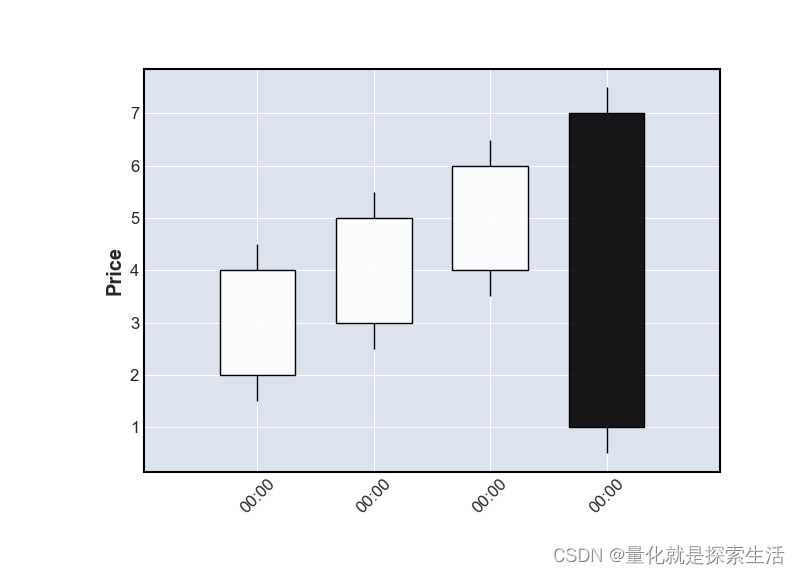
三连阳情况
第一根阳线:
O
P
E
N
−
3
<
C
L
O
S
E
−
3
OPEN_{-3} < CLOSE_{-3}
OPEN−3<CLOSE−3
第二根阳线:
O
P
E
N
−
2
<
C
L
O
S
E
−
2
O
P
E
N
−
3
−
N
e
a
r
<
=
O
P
E
N
−
2
<
=
C
L
O
S
E
−
3
+
N
e
a
r
C
L
O
S
E
−
2
>
C
L
O
S
E
−
3
OPEN_{-2} < CLOSE_{-2} \\ OPEN_{-3}-Near<= OPEN_{-2} <= CLOSE_{-3}+Near \\ CLOSE_{-2} > CLOSE_{-3}
OPEN−2<CLOSE−2OPEN−3−Near<=OPEN−2<=CLOSE−3+NearCLOSE−2>CLOSE−3
第三根阳线:
O
P
E
N
−
1
<
C
L
O
S
E
−
1
O
P
E
N
−
2
−
N
e
a
r
<
=
O
P
E
N
−
1
<
=
C
L
O
S
E
−
2
+
N
e
a
r
C
L
O
S
E
−
1
>
C
L
O
S
E
−
2
OPEN_{-1} < CLOSE_{-1} \\ OPEN_{-2}-Near<= OPEN_{-1} <= CLOSE_{-2}+Near \\ CLOSE_{-1} > CLOSE_{-2}
OPEN−1<CLOSE−1OPEN−2−Near<=OPEN−1<=CLOSE−2+NearCLOSE−1>CLOSE−2
第四根阴线:
O
P
E
N
0
>
C
L
O
S
E
−
1
C
L
O
S
E
0
<
O
P
E
N
−
3
OPEN_{0} > CLOSE_{-1} \\ CLOSE_{0} < OPEN_{-3}
OPEN0>CLOSE−1CLOSE0<OPEN−3
三连阴情况类似
重构代码(来自ta_CDL3LINESTRKE.c, 有修改, 只保留逻辑):
def CDL3LINESTRIKE_(open, high, low, close):
_len = len(open)
open, high, low, close = pd.Series(open), pd.Series(high), pd.Series(low), pd.Series(close)
if _len >= 9:
high_low_range_20per = (high - low) * 0.2
near = high_low_range_20per.rolling(5).mean().shift(1)
# 三阳线
# 第一根阳线
condition_1_1 = (close.shift(3) > open.shift(3))
# 第二根阳线
condition_1_2 = (close.shift(2) > open.shift(2)) & \
(close.shift(2) > close.shift(3)) & \
(open.shift(2) >= open.shift(3) - near.shift(3)) & \
(open.shift(2) <= close.shift(3) + near.shift(3))
# 第三根阳线
condition_1_3 = (close.shift(1) > open.shift(1)) & \
(close.shift(1) > close.shift(2)) & \
(open.shift(1) >= open.shift(2) - near.shift(2)) & \
(open.shift(1) <= close.shift(2) + near.shift(2))
# 第四根阴线
condition_1_4 = (close < open) & \
(open > close.shift(1)) & \
(close < open.shift(3))
cdl3linestrike = np.where(condition_1_1 & condition_1_2
& condition_1_3 & condition_1_4, 100, 0)
# 三阴线
# 第一根阴线
condition_2_1 = (close.shift(3) < open.shift(3))
# 第二根阴线
condition_2_2 = (close.shift(2) < open.shift(2)) & \
(close.shift(2) < close.shift(3)) & \
(open.shift(2) >= close.shift(3) - near.shift(3)) & \
(open.shift(2) <= open.shift(3) + near.shift(3))
# 第三根阴线
condition_2_3 = (close.shift(1) < open.shift(1)) & \
(close.shift(1) < close.shift(2)) & \
(open.shift(1) >= close.shift(2) - near.shift(2)) & \
(open.shift(1) <= open.shift(2) + near.shift(2))
# 第四根阳线
condition_2_4 = (close > open) & \
(open < close.shift(1)) & \
(close > open.shift(3))
cdl3linestrike = np.where(condition_2_1 & condition_2_2
& condition_2_3 & condition_2_4, -100, cdl3linestrike)
cdl3linestrike[:8] = 0
else:
cdl3linestrike = np.zeros(_len).astype(int)
return cdl3linestrike
CDLCONCEALBABYSWALL(藏婴吞没)
python函数原型:
cdlconcealbabyswall = CDLCONCEALBABYSWALL(open, high, low, close)
四日连续阴线,前两日无影线
第三日跌出实体缺口,但有不短的上影线,且最高价超过第二日收盘
第四日最高和最低价包裹第三日
底部信号
重构代码(来自ta_CDLCONCEALBABYSWALL.c, 有修改, 只保留逻辑):
def CDLCONCEALBABYSWALL_(open, high, low, close):
_len = len(open)
open, high, low, close = pd.Series(open), pd.Series(high), pd.Series(low), pd.Series(close)
if _len >= 14:
high_low_range = high - low
shadow_very_short = high_low_range.rolling(10).mean().shift(1) * 0.1
shadow_upper = high - np.maximum(close, open)
shadow_lower = np.minimum(close, open) - low
condition_1 = (close.shift(3) < open.shift(3)) & \
(shadow_upper.shift(3) < shadow_very_short.shift(3)) & \
(shadow_lower.shift(3) < shadow_very_short.shift(3))
condition_2 = (close.shift(2) < open.shift(2)) & \
(shadow_upper.shift(2) < shadow_very_short.shift(2)) & \
(shadow_lower.shift(2) < shadow_very_short.shift(2))
condition_3 = (close.shift(1) < open.shift(1)) & \
(shadow_upper.shift(1) > shadow_very_short.shift(1)) & \
(open.shift(1) < close.shift(2)) & \
(high.shift(1) > close.shift(2))
condition_4 = (close < open) & \
(high > high.shift(1)) & \
(low < low.shift(1))
cdlconcealbabyswall = np.where(condition_1 & condition_2 & condition_3 & condition_4, 100, 0)
else:
cdlconcealbabyswall = np.zeros(_len).astype(int)
return cdlconcealbabyswall
六. 五K线模型
CDLBREAKAWAY(脱离)
python函数原型:
cdlbreakaway = CDLBREAKAWAY(open, high, low, close)
以看涨脱离为例,大阴线后低开形成实体缺口,继续走低
第三日和第四日阴线的high和low持续走低
第五日反弹收盘在一二日缺口内(中文百科中无此要求)
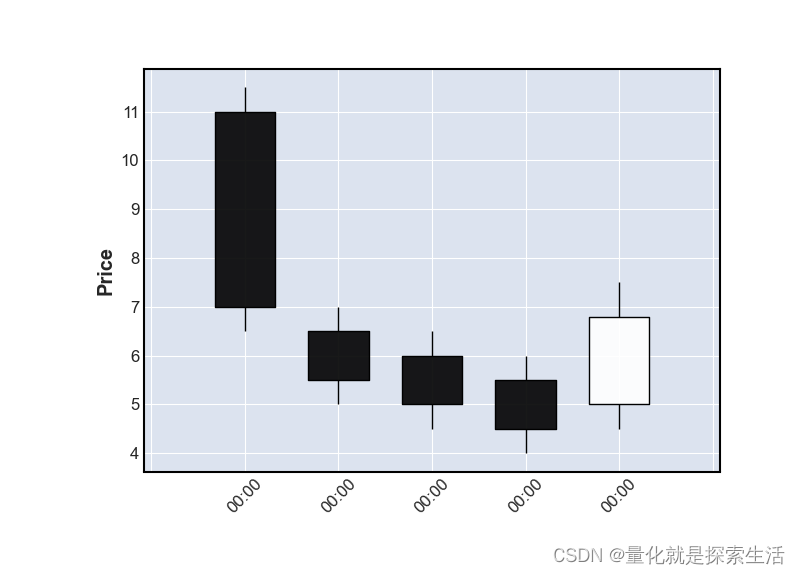
重构代码(来自ta_CDLBREAKAWAY.c, 有修改, 只保留逻辑):
def CDLBREAKAWAY_(open, high, low, close):
_len = len(open)
open, high, low, close = pd.Series(open), pd.Series(high), pd.Series(low), pd.Series(close)
if _len >= 15:
real_body = abs(open - close)
body_long = real_body.rolling(10).mean().shift(1)
# 看涨脱离
condition_1_1 = (close.shift(4) < open.shift(4)) & (real_body.shift(4) > body_long.shift(4))
condition_1_2 = (close.shift(3) < open.shift(3)) & (open.shift(3) < close.shift(4))
condition_1_3 = (close.shift(2) < open.shift(2)) & \
(low.shift(2) < low.shift(3)) & \
(high.shift(2) < high.shift(3))
condition_1_4 = (close.shift(1) < open.shift(1)) & \
(low.shift(1) < low.shift(2)) & \
(high.shift(1) < high.shift(2))
condition_1_5 = (close > open) & (close > open.shift(3)) & (close < close.shift(4))
# 看跌脱离
condition_2_1 = (close.shift(4) > open.shift(4)) & (real_body.shift(4) > body_long.shift(4))
condition_2_2 = (close.shift(3) > open.shift(3)) & (open.shift(3) > close.shift(4))
condition_2_3 = (close.shift(2) > open.shift(2)) & \
(low.shift(2) > low.shift(3)) & \
(high.shift(2) > high.shift(3))
condition_2_4 = (close.shift(1) > open.shift(1)) & \
(low.shift(1) > low.shift(2)) & \
(high.shift(1) > high.shift(2))
condition_2_5 = (close < open) & (close < open.shift(3)) & (close > close.shift(4))
cdlbreakaway = np.where(condition_1_1 & condition_1_2 & condition_1_3 & condition_1_4 & condition_1_5, 100, 0)
cdlbreakaway = np.where(condition_2_1 & condition_2_2 & condition_2_3 & condition_2_4 & condition_2_5,
-100, cdlbreakaway)
else:
cdlbreakaway = np.zeros(_len).astype(int)
return cdlbreakaway
免责声明
本文仅为技术解析文档,内容全部开放,不对任何个人或机构提供任何投资建议

